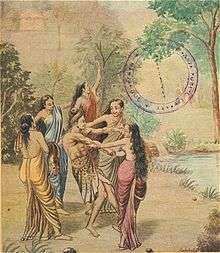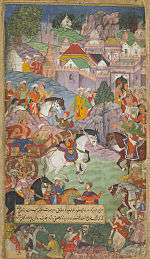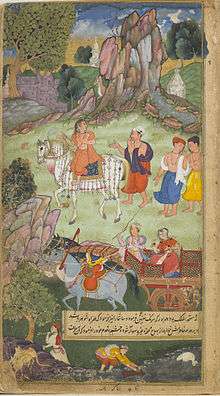Rishyasringa
| Rishyasringa | |
|---|---|
 Ṛṣyaśṛṅga lured into aṅgadēśa by dancing girls | |
| Information | |
| Family |
Vibhandaka (father) Urvashi (mother) |
| Spouse(s) | Shanta |
Rishyasringa (IAST: Ṛṣyaśṛṅga) was a boy born with the horns of a deer in Hindu-Buddhist mythology who became a seer and was seduced by a king's daughter, which had various results according to the variations in the story.
Names
Other names for Rishyasringa (Sanskrit: ऋष्यशृंग) include Shring-rishi; Odia: ୠଶ୍ୟଶ୍ରୁଙ୍ଗ; Kannada: ಋಷ್ಯಶೃಂಗ; Telugu:ఋష్యశృంగ (Deer-Horned); Pali: Isisiṅga; Thai: Kalaikot; Tamil: Kalaikottan, Chinese: 獨角仙人; pinyin: Dújiǎo Xiānrén; also Ēkaśṛṅga).
Hindu versions of the story

Rishyasringa was a boy born with the horns of a deer in Hindu-Buddhist mythology. His father was the Vibhandak Rishi, and his mother was a celestial paramour Urvashi. According to another legend, he was believed to have been born of a doe and from the slight protrusion of his forehead. According to legend, his father was seduced by the celestial danseuse Urvasi by order of Indra, the king of gods, who feared the yogic powers gained out of penance by the rishi could prove fatal to the very existence of heavenly world. The father was seduced and out of his relation with the danseuse was born Rishyasringa.
However, immediately after the child was born, Urvashi, after completing the duty she was sent for, left the infant child and her lover and made her way to the heavens. The incident left the father with extreme hatred towards women folk, and he raised the boy in a forest, isolated from society. He never saw any girls or women, and was not told of their existence. The tradition states that he was endowed with magical and miraculous powers.
The early upbringing of Rishyasringa is linked to the highland location in the central mid hill of Nepal now popular as Resunga in the Gulmi District of the Lumbini Zone. Stories about the unique setting of the special mountain that has attracted and made it the home to many famous mystic Yogis. The Saha Kings of Nepal have dedicated special respect and attention to its maintenance and arrangement and the religious circuit of Ridi-Rudrabeni-Resunga in the Gulmi district is a huge attraction for national and international tourists. The all-weather road that connects the Indian border of Sunauli (Uttar Pradesh) and passes through the Nepal's Sidharthanagar-Butwal-Palpa cities leading to the Ridi Sangam with Kali Gandaki and upward towards the district headquarters Tamghas.

In the usual version of the story, at the time that the boy becomes a young man, the kingdom of Anga suffers from drought and famine. The king, Romapada, is told that this can only be alleviated by a brahmin with the powers that come from observance of perfect chastity. The only such person is Rishyasringa. He has to be brought to the city, and be persuaded to carry out the necessary ceremonies. Despite his fear of the power and anger of the boy's father, the king sends young women to introduce the boy into normal society. This was successfully done by Vaishali, Rishyasringa uses his powers, the kingdom receives bountiful rains and Rishyasringa marries Shanta. Much of the story is taken up by accounts of the feelings of the young man as he becomes aware of women for the first time.
In another version of the story, the forest in which the boy is brought up is part of Anga. The boy's upbringing without knowledge of women is itself the cause of the troubles of the kingdom.
The story can be found in both the Ramayana and the Mahabharata. According to the Ramayana, Ekashringa was the chief priest when the king Dasharatha performed a yajna to beget progeny, and Rama, Bharata, and the twins Lakshmana and Shatrughna were born.
Buddhist versions of the story
In Naḷinikā Jātaka (Jā 526), a sage lives alone in the Himālayas, there is semen in the urine he passes, and a deer who happens to eat the grass in that place gets pregnant from it. A human boy is later born to the deer and he is brought up in complete seclusion from mankind, and most importantly, from womankind.
The boy's ascetic power becomes so great that Sakka (the Buddhist Indra) in his heaven is worried by it and causes a drought to occur in the country and blames it on the boy. He then convinces the King to send his daughter to seduce him and to break his power. The King and his daughter accept Sakka's reasoning and in good faith – and for the benefit of the country – agree to the plot.
The girl dresses up as an ascetic and while the father (the Bodhisatta) is away gathering roots and fruits in the forest, she manages to seduce the boy, who has never seen a woman before. Through their revelling, the boy does indeed lose his powers, the girl then leaves. When his father returns, the boy, who has become infatuated with his new friend, tells him all about it, only to be instructed and rebuked by his father, and repent his actions.
This is not the only story of Isisiṅga that appears in the Jātakas. There is another, and somewhat similar, story just a few pages before, and which is referred to in this story. That is Jātaka 523, the Alambusājātaka, but there Sakka chooses a heavenly nymph to seduce the ascetic. The outcome is the same, the sage is seduced, repents and Sakka is thwarted, but some reason he does not seem upset. In fact, he grants a boon to the seductress.
The story also appears in the Mahāvastu (Jones' translation pp. 139–147), but Ekaśr̥ṅga, as he is known there, is the Bodhisattva, and Nalinī is Yaśodharā in an earlier existence. There is a variation in the story as without his knowing it, Ekaśr̥ṅga is married to the girl and has to take up his responsibilities, eventually becoming the King and having 32 children, before he retires once again to the forest and regains his former powers.
Kigga
The town Kigga near by Sringeri is the place today holds religious values based on Rishyashringa. Lord Shiva temple in the town is said to be worshiped by Rishyashringa. In the modern days also the Jagadguru of Sringeri Sharada Peetham performs pooja at Kigga Sri Rushasringeswara temple for rain or to reduce rain.
Sringeri
The town of Sringeri in Karnataka is named after this sage. The name Sringeri is derived from Rishya sringa giri (hill), then sringa giri and now sringeri. This is based on the legend that Sage Rishyasringa performed penance here. The Advaitin philosopher, Adi Shankara, founded the Sringeri Sharada Peetham at Sringeri after seeing a hooded snake giving shelter to a frog in labor, in spite of snakes and frogs being mortal enemies. Adi Shankara realized that the place must have been a spot of penance and established the Dakshninamnaya Sharada Peetham (Southern Seat of Goddess Sharada) here.
Present day

There is a temple of Rishyashringa in Kullu district of Himachal Pradesh. Idol of Shringa Rishi with goddess Shanta resides in the temple. This place is about 50 km from Kullu. Lord Shringa is the presiding deity of this secluded valley named Banjar. The descendants of Shanta and Rishyasringa are Sengar Rajputs who are called the only Rishivanshi rajputs.
There is a sect of Brahmins in Rajasthan state known as Shringi/ Sukhwal Brahmins who associate their lineage to Shring Rishi and Mata Shanta.
See also
References
- Dictionary of Hindu Lore and Legend (ISBN 0-500-51088-1) by Anna Dallapiccola
External links
- Shringirishi.org
- Translation of Bala Kanda in Rāmāyaṇa, Sarga 9 by Desiraju Hanumanta Rao
- Text and Translation of Naḷinikā Jātaka and its Commentary by Ānandajoti Bhikkhu
.jpg)